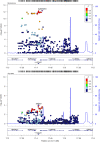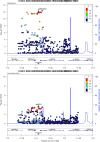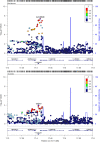Genetically proxied antidiabetic drugs targets and stroke risk
- PMID: 37777789
- PMCID: PMC10544120
- DOI: 10.1186/s12967-023-04565-x
Genetically proxied antidiabetic drugs targets and stroke risk
Abstract
Background: Previous studies have assessed the association between antidiabetic drugs and stroke risk, but the results are inconsistent. Mendelian randomization (MR) was used to assess effects of antidiabetic drugs on stroke risk.
Methods: We selected blood glucose-lowering variants in genes encoding antidiabetic drugs targets from genome-wide association studies (GWAS). A two-sample MR and Colocalization analyses were applied to examine associations between antidiabetic drugs and the risk of stroke. For antidiabetic agents that had effect on stroke risk, an independent blood glucose GWAS summary data was used for further verification.
Results: Genetic proxies for sulfonylureas targets were associated with reduced risk of any stroke (OR=0.062, 95% CI 0.013-0.295, P=4.65×10-4) and any ischemic stroke (OR=0.055, 95% CI 0.010-0.289, P=6.25×10-4), but not with intracranial hemorrhage. Colocalization supported shared casual variants for blood glucose with any stroke and any ischemic stroke within the encoding genes for sulfonylureas targets (KCNJ11 and ABCC8) (posterior probability>0.7). Furthermore, genetic variants in the targets of insulin/insulin analogues, glucagon-like peptide-1 analogues, thiazolidinediones, and metformin were not associated with the risk of any stroke, any ischemic stroke and intracranial hemorrhage. The association was consistent in the analysis of sulfonylureas with stroke risk using an independent blood glucose GWAS summary data.
Conclusions: Our findings showed that genetic proxies for sulfonylureas targets by lowering blood glucose were associated with a lower risk of any stroke and any ischemic stroke. The study might be of great significance to guide the selection of glucose-lowering drugs in individuals at high risk of stroke.
Keywords: Antidiabetic drugs; Mendelian randomization; Stroke; Sulfonylurea.
© 2023. BioMed Central Ltd., part of Springer Nature.
Conflict of interest statement
The authors declare that they have no competing interests.
Figures









Similar articles
-
Repurposing antidiabetic drugs for rheumatoid arthritis: results from a two-sample Mendelian randomization study.Eur J Epidemiol. 2023 Jul;38(7):809-819. doi: 10.1007/s10654-023-01000-9. Epub 2023 Apr 13. Eur J Epidemiol. 2023. PMID: 37052755 Free PMC article.
-
Genetically proxied glucose-lowering drug target perturbation and risk of cancer: a Mendelian randomisation analysis.Diabetologia. 2023 Aug;66(8):1481-1500. doi: 10.1007/s00125-023-05925-4. Epub 2023 May 12. Diabetologia. 2023. PMID: 37171501 Free PMC article.
-
Exploring antidiabetic drug targets as potential disease-modifying agents in osteoarthritis.EBioMedicine. 2024 Sep;107:105285. doi: 10.1016/j.ebiom.2024.105285. Epub 2024 Aug 16. EBioMedicine. 2024. PMID: 39153411 Free PMC article.
-
Antidiabetic drugs and stroke risk. Current evidence.Eur J Intern Med. 2018 Feb;48:1-5. doi: 10.1016/j.ejim.2017.09.019. Epub 2017 Sep 20. Eur J Intern Med. 2018. PMID: 28939005 Review.
-
Oral antidiabetic agents: current role in type 2 diabetes mellitus.Drugs. 2005;65(3):385-411. doi: 10.2165/00003495-200565030-00005. Drugs. 2005. PMID: 15669880 Review.
Cited by
-
Impact of Glucagon-like Peptide-1 Receptor Agonists on Mental Illness: Evidence from a Mendelian Randomization Study.Int J Mol Sci. 2025 Mar 18;26(6):2741. doi: 10.3390/ijms26062741. Int J Mol Sci. 2025. PMID: 40141382 Free PMC article.
-
Causal relationship between novel antidiabetic drugs and ischemic stroke: a drug-targeted Mendelian randomization study.Front Cardiovasc Med. 2024 Sep 24;11:1449185. doi: 10.3389/fcvm.2024.1449185. eCollection 2024. Front Cardiovasc Med. 2024. PMID: 39380626 Free PMC article.
-
Leveraging Mendelian randomization to inform drug discovery and development for ischemic stroke.J Cereb Blood Flow Metab. 2024 Dec 4:271678X241305916. doi: 10.1177/0271678X241305916. Online ahead of print. J Cereb Blood Flow Metab. 2024. PMID: 39628323 Free PMC article. Review.
-
Dissecting Causal Relationships Between Antihypertensive Drug, Gut Microbiota, and Type 2 Diabetes Mellitus and Its Complications: A Mendelian Randomization Study.J Clin Hypertens (Greenwich). 2025 Jan;27(1):e14968. doi: 10.1111/jch.14968. J Clin Hypertens (Greenwich). 2025. PMID: 39821516 Free PMC article.
-
Mendelian randomization studies on ischemic stroke: a field synopsis and systematic review.J Transl Med. 2025 Aug 22;23(1):955. doi: 10.1186/s12967-025-06992-4. J Transl Med. 2025. PMID: 40847399 Free PMC article. Review.
References
-
- GBD 2015 DALYs and Hale Collaborators Global, regional, and national disability adjusted life-years (DALYs) for 315 diseases and injuries and healthy life expectancy (HALE), 1990–2015: a systematic analysis for the global burden of disease study 2015. Lancet. 2016;388:1603–58. doi: 10.1016/S0140-6736(16)31460-X. - DOI - PMC - PubMed
-
- GBD 2015 Mortality and Causes of Death Collaborators Global, regional, and na tional life expectancy, all-cause mortality, and cause-specifific mortality for 249 causes of death, 1980–2015: a systematic analysis for the global burden of disease study 2015. Lancet. 2016;388:1459–544. doi: 10.1016/S0140-6736(16)31012-1. - DOI - PMC - PubMed
-
- Kernan WN, Ovbiagele B, Black HR, et al. Guidelines for the prevention of stroke in patients with stroke and transient ischemic attack: a guideline for healthcare professionals from the american heart association/american stroke association. Stroke. 2014;45:2160–236. doi: 10.1161/str.0000000000000024. - DOI - PubMed
MeSH terms
Substances
LinkOut - more resources
Full Text Sources
Medical

